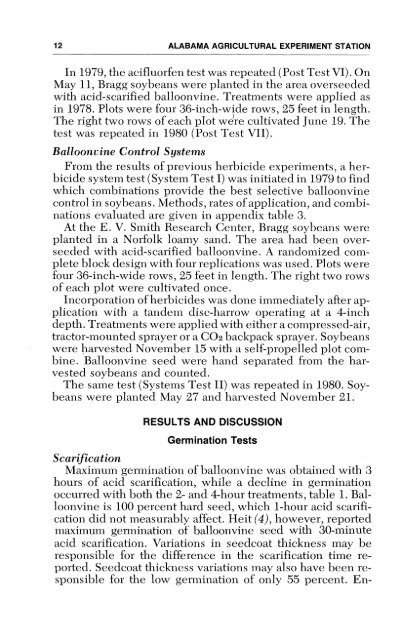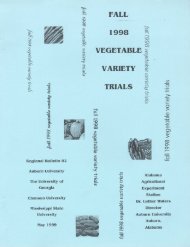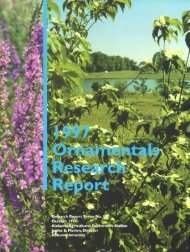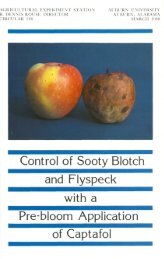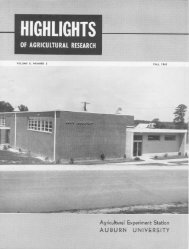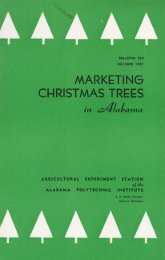Balloonvine Biology and Control in Soybeans - Auburn University ...
Balloonvine Biology and Control in Soybeans - Auburn University ...
Balloonvine Biology and Control in Soybeans - Auburn University ...
You also want an ePaper? Increase the reach of your titles
YUMPU automatically turns print PDFs into web optimized ePapers that Google loves.
12<br />
ALABAMA AGRICULTURAL EXPERIMENT STATION<br />
In 1979, the acifluorfen test was repeated (Post Test VI). On<br />
May 11, Bragg soybeans were planted <strong>in</strong> the area overseeded<br />
with acid-scarified balloonv<strong>in</strong>e. Treatments were applied as<br />
<strong>in</strong> 1978. Plots were four 36-<strong>in</strong>ch-wide rows, 25 feet <strong>in</strong> length.<br />
The right two rows of each plot were cultivated June 19. The<br />
test was repeated <strong>in</strong> 1980 (Post Test VII).<br />
<strong>Balloonv<strong>in</strong>e</strong> <strong>Control</strong> Systems<br />
From the results of previous herbicide experiments, a herbicide<br />
system test (System Test I) was <strong>in</strong>itiated <strong>in</strong> 1979 to f<strong>in</strong>d<br />
which comb<strong>in</strong>ations provide the best selective balloonv<strong>in</strong>e<br />
control <strong>in</strong> soybeans. Methods, rates of application, <strong>and</strong> comb<strong>in</strong>ations<br />
evaluated are given <strong>in</strong> appendix table 3.<br />
At the E. V. Smith Research Center, Bragg soybeans were<br />
planted <strong>in</strong> a Norfolk loamy s<strong>and</strong>. The area had been overseeded<br />
with acid-scarified balloonv<strong>in</strong>e. A r<strong>and</strong>omized complete<br />
block design with four replications was used. Plots were<br />
four 36-<strong>in</strong>ch-wide rows, 25 feet <strong>in</strong> length. The right two rows<br />
of each plot were cultivated once.<br />
Incorporation of herbicides was done immediately after application<br />
with a t<strong>and</strong>em disc-harrow operat<strong>in</strong>g at a 4-<strong>in</strong>ch<br />
depth. Treatments were applied with either a compressed-air,<br />
tractor-mounted sprayer or a CO2 backpack sprayer. <strong>Soybeans</strong><br />
were harvested November 15 with a self-propelled plot comb<strong>in</strong>e.<br />
<strong>Balloonv<strong>in</strong>e</strong> seed were h<strong>and</strong> separated from the harvested<br />
soybeans <strong>and</strong> counted.<br />
The same test (Systems Test II) was repeated <strong>in</strong> 1980. <strong>Soybeans</strong><br />
were planted May 27 <strong>and</strong> harvested November 21.<br />
RESULTS AND DISCUSSION<br />
Germ<strong>in</strong>ation Tests<br />
Scarification<br />
Maximum germ<strong>in</strong>ation of balloonv<strong>in</strong>e was obta<strong>in</strong>ed with 3<br />
hours of acid scarification, while a decl<strong>in</strong>e <strong>in</strong> germ<strong>in</strong>ation<br />
occurred with both the 2- <strong>and</strong> 4-hour treatments, table 1. <strong>Balloonv<strong>in</strong>e</strong><br />
is 100 percent hard seed, which 1-hour acid scarification<br />
did not measurably affect. Heit (4), however, reported<br />
maximum germ<strong>in</strong>ation of balloonv<strong>in</strong>e seed with 30-m<strong>in</strong>ute<br />
acid scarification. Variations <strong>in</strong> seedcoat thickness may be<br />
responsible for the difference <strong>in</strong> the scarification time reported.<br />
Seedcoat thickness variations may also have been responsible<br />
for the low germ<strong>in</strong>ation of only 55 percent. En-


